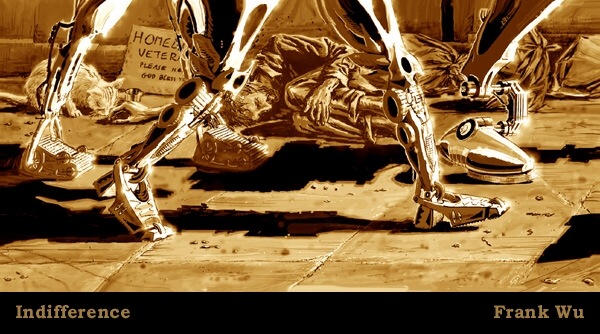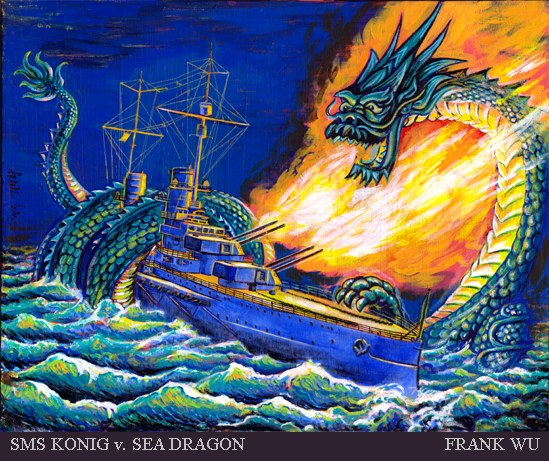Editor's Interview: Frank Wu
Reprinted from Lenox Ave. ezine, issue 2, August 2004
Your colors and lines
are very striking and bold, quite different from much fantasy artwork. What
drew you to this method, or what drew you away from "standard" fantasy art?
I sometimes use really bright or contrast-y or
conflicting colors, like in some of the pieces here. Sometimes I use more
sedate colors, but I often find these pretty but boring. I think my color
sense was really skewed by TV. I grew up watching a tiny grainy black and
white TV in a smelly dingy basement, and I loved collecting poorly reproduced
fotos from magazines about old sci-fi movies. That skewed me toward loving
high contrast images. Then when we finally got a color TV, the first thing I
remember watching
was the ďStar TrekĒ episode ďThe Doomsday Machine,Ē and all those bright pinks
and fuchsias really wacked out my sense of color.
What do you feel your art says about you? (Or, what
do you hope it says?)
I want my art to express my different emotions. Sometimes I feel so happy,
sometimes I feel so sad, sometimes I feel so happy, but mostly you just make
me mad. To quote Lou Reed. I want happy art, sad art, angry art. I donít
always succeed, but thatís what Iím trying to do, create emotionally visceral
pieces.
Iíve heard writers say about rejection letters that magazine editors arenít
rejecting you, theyíre just rejecting little bits of paper. In a way, thatís
a lie. If you feel passionately about something, it should come out in your
writing or art. No tears in the author, no tears in the reader. The audience
can tell if a writer or artist was emotionally invested in a piece. And, so,
in a way, a magazine editor is rejecting you.
What has your art taught you about yourself?
I find that sometimes I hide behind my art. Sometimes I think that Iím not
all that interesting a person, but my art can be. Sometimes I prefer to talk
about my art than about myself.
When and where have you, or do you, learn most about art?
I think artists need to be omnivores. An artist should be familiar with all
different art styles, from pulp artists to Japanese prints to Abstract
Expressionists to cave paintings to electronic landscapes to Constructivists
to Futurists to Greek icons to photojournalism to Broadway set
design...everything. The world is full of interesting images - I love
electronic micrographs of insects and fibers. One of the most interesting
books Iíve
ever seen is a thesis on fine cell structure, which was micrographic cross
sections of cells. Everything is interesting to look at, and anything can be
an inspiration for an art piece.
What do you see as the greatest challenge to you as an artist?
The greatest challenge I find as an artist is to humble myself to accept other
peopleís advice when Iím wrong about something. It was a great relief to hear
that the writer Jay Lake, whoís sold a hundred stories, still humbly submits
each new story to a readerís group. They give him feedback and he edits the
stories again before sending them out. Artists can easily fall into an
arrogant, self-important trap, and itís important to remember that just
because we think weíre great, that doesnít mean our art isnít perfect
or canít be improved.
What would be your "dream" project? The cover of a favorite book? A
mural on a favorite building? etc.
My dream as a creative person is to be mentioned on ďThe Simpsons.Ē Then Iíll
know that Iíve made it.
Frankís Comments About the Pieces on Display:
Love is the Plan - The Plan is Death
My mind works by trying to make connections between things, sometimes
between things that aren't obviously related. This piece was inspired by two
things: James Tiptree Jr.'s classic story about male insects who give their
bodies for food, so the females can survive the long winter. And
Michelangelo's Pieta, about the Christ who gave his Life so that we might have
eternal Life.
Indifference and Ad Astra (cover):
I still believe that rock and roll can change the world, and that art can
change the world. One thing that makes me sad is that there are so many
shocking things going on these days, and very few, if any, sci-fi or fantasy
artists are addressing these issues. I see cartoonists and political artists
doing this, but not genre artists. Why? In "Indifference," I wanted to
address the problem of homelessness. Why do we just casually throw people
away? Here we see robots walking by, ignoring a homeless guy. I used robots
because every time we pass someone in need and do nothing, it costs us a
little bit of our humanity, until we have none left.
In "Ad Astra," I revisited the theme of "Indifference," but with a
difference. What I wanted to show was the march of technological achievement,
symbolized by the space age. Recently George Bush promised to help us return
to the moon and go to Mars. This is great, but we have to remember not to
leave people behind here on earth.
So many things are going on in the world. I had been planning on doing a
magazine cover commenting on the mistreatment of prisoners at Guantanamo.
Before I started the piece, though, the release of photos of U.S. soldiers
humiliating Iraqi prisoners horrified the world. And rightfully so. Pictures
of men stripped naked, hooded, piled up like cordwood. A cackling female
soldier, cigarette in mouth, pointing, thumbs up, at a naked manís genitals.
The same soldier leading another prisoner on a leash. Even worse photos may
be forthcoming. How can people act this way? How can her family members deny
that she did this, or whine that the fotos must have been faked? How can the
government cover this up these atrocities for months and months, pretending it
just didn't happen? And how can we, as artists, not shout out?
Konig
Sometimes, with "Indifference" and "Ad Astra," it's important for me to get on
my high horse and address Important Issues. Sometimes, though, it's just fun
to kick back and have fun. This piece was an excuse to paint a battleship and
a Chinese dragon. The painting is part of a series I'm doing with William F.
Wu that I call "Dragon v. Dreadnought." It's about dragons fighting World War
I tri-planes and tanks and early subs, and... battleships, all in an alternate
history. There's no special meaning here, this piece was just for fun.


